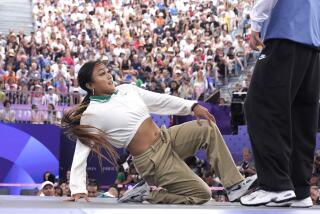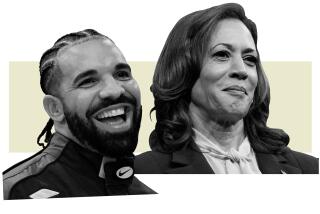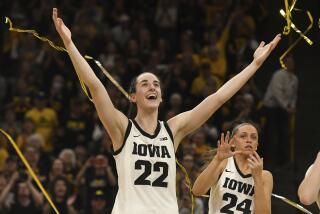COMMENTARY : The Issues Are...
- Share via
To use the word loosely, he danced. Some witnesses believed he had so many itches he couldn’t scratch them all, though try he did as music blared in the arena. One day Bill Russell watched Dancin’ Harry and said, “Well, that proves that not all of us have rhythm.”
Had Russell’s wisecrack been delivered by a white broadcaster with one or two words changed, my, my. The furor would have matched that raised when Howard Cosell praised the quickness and guile of a pass receiver by calling him “that little monkey.” But Russell could turn the stereotype into harmless and ironic humor because he, like Dancin’ Harry, is African American.
It is a measure of the meanness of our times that a white man saying Russell’s words would be branded a racist. As evidence we have Jimmy (The Greek) Snyder and Al Campanis.
Blind men but not mean men, they lost the jobs they’d created over a lifetime when they stumbled into the unforgiving thicket of racial argument. The Greek said African Americans had been bred to be strong by slave owners; Campanis said African Americans “lack some of the necessities” to be front-office management in baseball.
Now comes Roger Bannister, the Englishman who in 1954 became the first man to run a mile in under four minutes. He is Lord Bannister these days, a retired neurosurgeon.
It’s his argument that “black sprinters and black athletes in general all seem to have certain natural anatomical advantages” over whites.
Bannister told a conference of British scientists that he thinks black athletes’ muscles, better adapted to hot climates, are better at providing energy quickly. He also suggests blacks could have better power-to-weight ratio because they have less fatty tissue under the skin. He says, “Perhaps there are anatomical advantages in the length of the Achilles’ tendon, the longest tendon in the body.”
In any case, Bannister says he is “prepared to risk political incorrectness by drawing attention to the seemingly obvious but under-stressed fact” of black athletes’ superiority.
Certainly that superiority is obvious in the United States. We need only count African Americans at the highest levels, need only examine their work. In football, basketball, baseball and track, African Americans dominate their white contemporaries.
There’s no great need to get all scientific about it, either. Just walk through a professional team’s locker room. The good bodies belong to the African Americans. Maybe 11 percent of the United States population, African Americans account for maybe 60 percent of professional athletes.
Some scientists, unwilling to be politically incorrect, would explain these numbers by saying African Americans succeed in sports because they want and need that success more than whites do. That argument is too simplistic by a mile, says the New York sociologist Steven Goldberg.
He is a City College of New York professor who insists there are physical differences between races. Writing in The New York Times, Goldberg says, “While Jewish boxers, Irish football players and the like have demonstrated that poverty can engender athletic performance disproportionate to population representation, it is ludicrous to attempt to explain the astonishing athletic performance of blacks in such terms.”
He cites the 100-meter dash as a pure test of athletic ability, more a matter of reflex than learning, and says the 50 top sprinters in America are African Americans. “Likewise,” Goldberg says, “the jumping ability blacks exhibit on the basketball court is not attributable to black parents telling their children to ‘Jump, jump, jump or you’ll never get out of the ghetto.’ Physiology is in all likelihood responsible for the superior black jumping ability.”
Goldberg acknowledges the dangerous uses to which such talk can be put. He knows any claim of difference can be used to claim differences that do not exist. He writes, “It is understandable, though not scientifically forgivable, that many would deny a physiological basis to all race differences; bogus claims of such differences have helped justify injustice.”
For instance, some white folks have persuaded themselves that if blacks are superior physically, they must be inferior intellectually; that they succeed by being “natural athletes” while whites succeed by being smart. Isiah Thomas has bridled at the stereotype: “It’s like I came dribbling out of my mother’s womb.” He came with a gift, no doubt; but neither is there doubt that he worked at his gift. The truth is, great African American athletes come with bodies and brains.
We all want to be somebody. Boys want to be men. For whites, the question of being somebody is answerable a thousand ways. The question is less easily answered by African Americans, too often the victims of racism in a thousand ways. For them the question of self-esteem is often unanswerable in any way.
They must search for ways to heal what Tommy Heinsohn once called a “love ache.” The old Celtics coach spoke of Larry Bird, his white star, but he spoke, too, of all the great ones. He said they needed success to heal the ache of love missing from their lives. When Deion Sanders came into our lives, wearing all that jewelry, he wore it because it spoke for him; it said, “Look at me! I am somebody!”
Twenty-five years ago, the African American author James Baldwin wrote, “Every Negro boy realizes, at once, profoundly, because he wants to live, that he stands in great peril and must find, with speed, a ‘thing,’ a gimmick, to lift him out, to start him on his way. And it does not matter what the gimmick is.”
For Isiah Thomas and Michael Jordan and Bill Russell, maybe even for Dancin’ Harry, the thing was sports.
More to Read
Go beyond the scoreboard
Get the latest on L.A.'s teams in the daily Sports Report newsletter.
You may occasionally receive promotional content from the Los Angeles Times.










